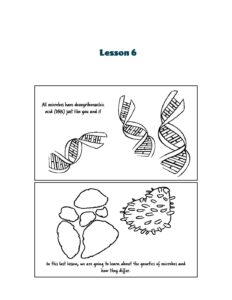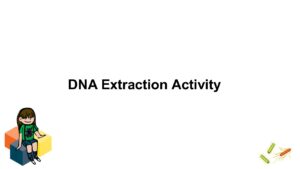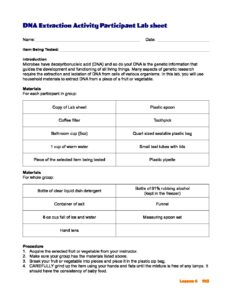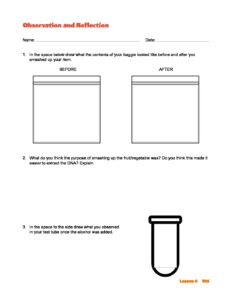Lesson 6: DNA Extraction Activity
Youth extract DNA from fruit using everyday items.
Key Teaching Points
- All living organisms have deoxyribonucleic acid (DNA), including microbes.
- DNA is the genetic information that guides the development and functioning of all living things.
- DNA extraction is the process scientists follow to remove the genetic information from organisms to gain an understanding of their genetic properties.
Learner Outcomes
- Experience how to extract DNA from different fruits and vegetables and compare their findings.
- Gain an understanding of the importance of DNA extraction and how microbiologists use DNA in their careers.
Skill Level: 6-8th grade
Success Indicators
- Participants will understand the process of DNA extraction in its relation to microbiology.
- Participants will successfully extract DNA from a sample of fruit or vegetable.
Life Skills
Teamwork, Critical Thinking, Communication, Problem Solving
Time Needed
1 Day (90 minutes)
Space
Classroom or area where participants can work in groups
Suggested Group Size
4-5 participants per group
Materials
Materials List
For Facilitator:
- Knife to peel any fruit as necessary
- Kiwi
- Strawberries
- Crushed tomatoes
- Bananas
- Peaches
For each participant:
- Coffee Filter
- Bathroom cup (5 oz)
- 1 cup of warm water (tap water)
- Piece of the selected item being tested
- Plastic Spoon
- Toothpick
- Quart sized sealable plastic bag
- Small test tube with lid
- Plastic Pipette
- Hand lens
For each group:
- Bottle of clear liquid dish detergent
- Container of salt
- 8oz cup full of ice and water
- Extra plastic bags in case any group members break their bags during the experiment
- Bottle of 91% rubbing alcohol (kept in freezer)
- Colored pencils
- Funnel
- Measuring spoon set
- Test tube brushes
Important Note
Keep the alcohol in the freezer for at least 2 hours until just before this lesson begins.
Introduction
Introduction
All microbes have deoxyribonucleic acid (DNA) and so do you! DNA is the genetic information that guides the development and functioning of all living things. Many aspects of genetic research require the extraction and isolation of DNA from cells of various organisms.
DNA extraction is the process scientists follow to remove the genetic information from organisms to gain an understanding of their genetic properties. DNA extraction is used for many reasons in the microbiology field. Scientists can look at the DNA of an organism to understand its genetic information as well as its common ancestors.
In this activity, participants will gain a full understanding of how DNA can be extracted from various fruits and vegetables. Participants will use common household products to remove the DNA strands from these items and compare the different DNA strands. This will allow participants a chance to observe genetic information and understand how this relates to the microbiology profession.
Before the Activity
- Make sure the materials listed above are ready and available for the participants to complete the DNA extraction activity.
- Note: Frozen fruit will work for this learning experience.
- Prepare technology to show the presentation to the class.
- Prepare copies of the DNA Extraction Activity Participant Lab Sheet for each participant.
- Prepare copies of the Observation and Reflection handout for each participant.
- Prepare one copy of the DNA Extraction Activity Participant Lab Sheet for facilitator use.
- Peel any fruit or vegetable that has a thick skin before distributing to the participants.
- Place the alcohol in the freezer at least two hours before use.
- Print or prepare a model of DNA to show participants.
Lesson
Opening Questions
- What is this a picture/model of?
- Why do you think if it is inside of every tiny cell in your body that we can know what it looks like?
Follow-up questions:
- What are some organisms that you think have very similar DNA?
- If they have similar DNA, what does this mean about some of their ancestors?
- How do you think scientists extract DNA from organisms?
- Do you think this is a difficult process? Why or why not?
- Why do you think it is important for us to know how to extract DNA from various organisms?
Let’s Do It!
- Bring in a model or a picture of DNA on the day of the activity. Tell participants that this model/picture is inside every single cell in their body.
- Ask the Opening Questions.
- What is this a picture/model of?
- Why do you think if it is inside of every tiny cell in your body that we can know what it looks like?
- Continue to explain to participants that many organisms have similar DNA to other organisms and it only takes a slight change in the DNA sequence to make a completely new organism.
- Ask the first two Follow-up questions.
- What are some organisms that you think have very similar DNA?
- If they have similar DNA what does this mean about some of their ancestors?
- Explain to participants that scientists have figured out ways to extract DNA from organisms so they can compare their genetic information to other living things. Tell participants that this is how we have been able to learn a great deal about organisms that lived many years ago and also find modern-day organisms that they are closely related to.
- Ask the final Follow-Up Questions.
- How do you think scientists extract DNA from organisms?
- Do you think this is a difficult process? Why or why not?
- Why do you think it is important for us to know how to extract DNA from various organisms?
- Explain to participants that today they are going to experience how to extract DNA from different fruits and vegetables and compare their findings to others’. Participants will also gain a better understanding of the importance of DNA extraction and how microbiologists use DNA in their careers.
- Show the presentation to the class. Have participants
engage in discussion about the information and the purpose of
DNA extraction. - Divide the participants into groups of 4 or 5 and assign them a group number and an item to test as indicated in the list below:
- Kiwi
- Strawberry
- Crushed Tomatoes
- Bananas
- Peaches
- Direct participants to form their groups.
- Read over the instructions for the DNA extraction with the class
as necessary. - Once the groups have finished their experiments, have participants complete the Observation and Reflection handout questions.
- As applicable, ask participants to share and discuss their answers from their Observation and Reflection handout with the class.
- Recycle all test tubes used in the experiment for use again by washing using warm water, detergent, and test tube brushes. Rinse each test tube thoroughly with warm water followed by alcohol. Turn the test tubes upside down and allow them to dry on a paper towel.
- Clean up the work area and return materials to the proper locations.
Assets
Dig Deeper
Have students complete the writing prompt:
Think about things about yourself that are determined by your DNA. Where did some of these qualities about yourself come from? Was it passed possibly from your parents? What about your grandparents?









